说到JMeter后端监听器,大家接触比较多的是Influxdb监听器InfluxdbBackendListenerClient,可以将测试报告实时推送到Influxdb,然后用Grafana展示。但是这种方式在大并发情况下,会因为吞吐量过大,Influxdb本身的性能瓶颈,无法支撑(Influxdb崩溃是常有的事),所以使用Kafka监听器就很有必要了,Kafka作为消息队列中间件,可以起到缓冲器的作用。
本篇文章包括如下五个部分内容:
1、Kafka后端监听器原理介绍
参考 JMeter中的后端监听器_HenryXiao8080的博客
2、下载和使用
提供监听器源码路径
3、通过后端监听器收集测试结果
介始如何通过telegraf收集kafka结果数据
4、通过Grafana进行结果展示
介绍如何通过修改telegraf的配置,获取支持grafana展现的数据
5、Kafka监听器插件扩展开发
介绍如何通过二次开发,扩展监听不同的性能指标
6、有关influxdb2.x的应用介绍
通过kafka监听器可以向influxdb2推送数据
一、Kafka后端监听器原理介绍
jmeter-backend-listener-kafka其实就是通过继承JMeter的AbstractBackendListenerClient来将异步获取到的测试结果集SampleResult进行相应处理(与JMeter原生自带的influxdb、graphite后端监听器原理一样),然后将元数据上报至kakfa,这样你就可以通过消费kafka Topic异步来接收测试结果集:
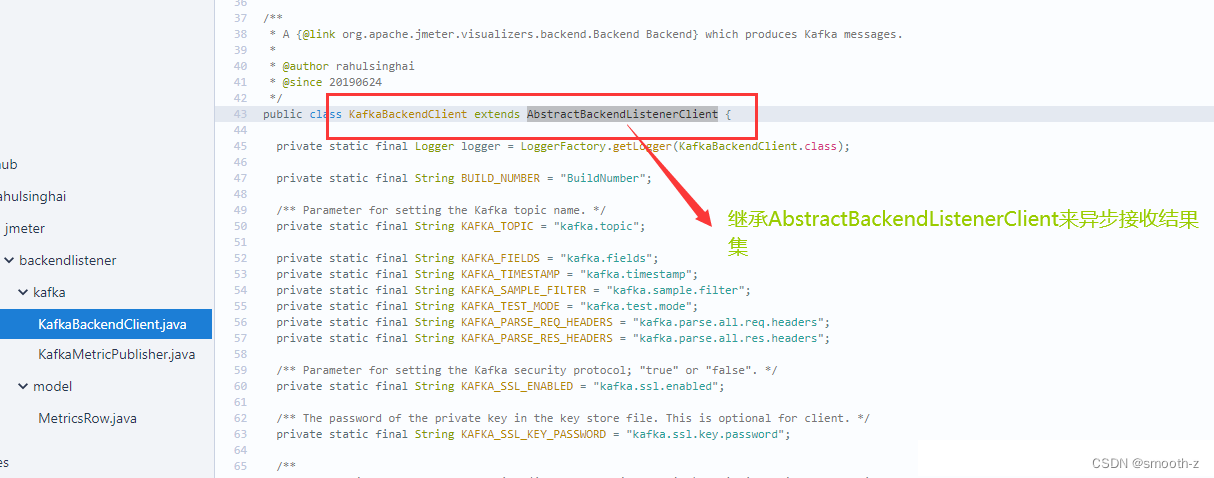
通过实现的handleSampleResults方法来处理数据并上报至kafka:
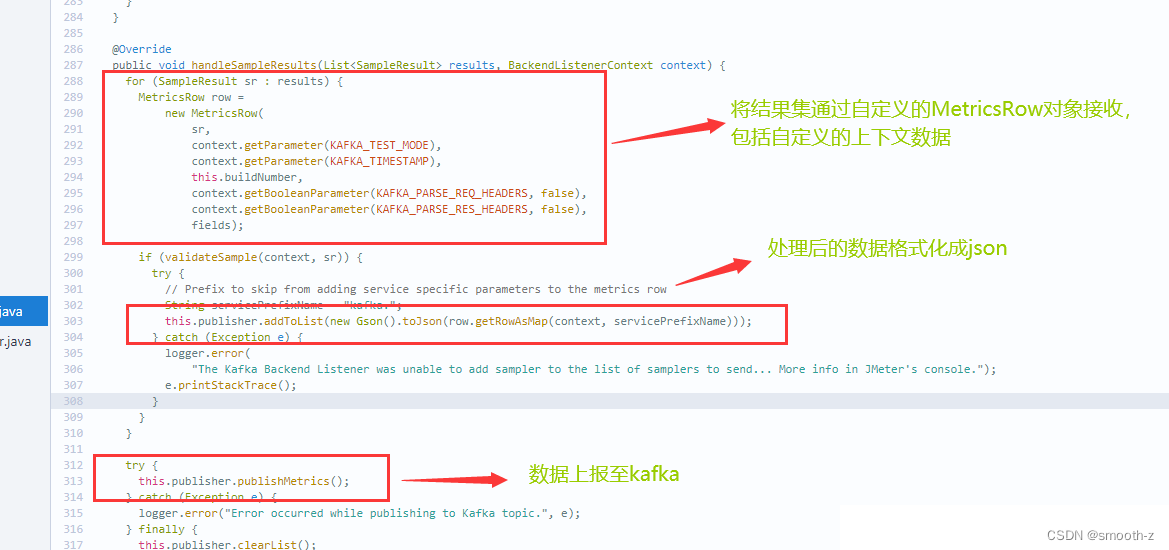
二、下载和使用Kafka后端监听器
我们可以从两个地方下载源码或releases的jar包,如下:
原始开源路径:https://github.com/rahulsinghai/jmeter-backend-listener-kafka
Metersphere路径:https://github.com/metersphere/jmeter-backend-listener-kafka
把jar包jmeter.backendlistener.kafka-1.0.4.jar放到Jmeter的lib\ext后重启JMeter即可支持:
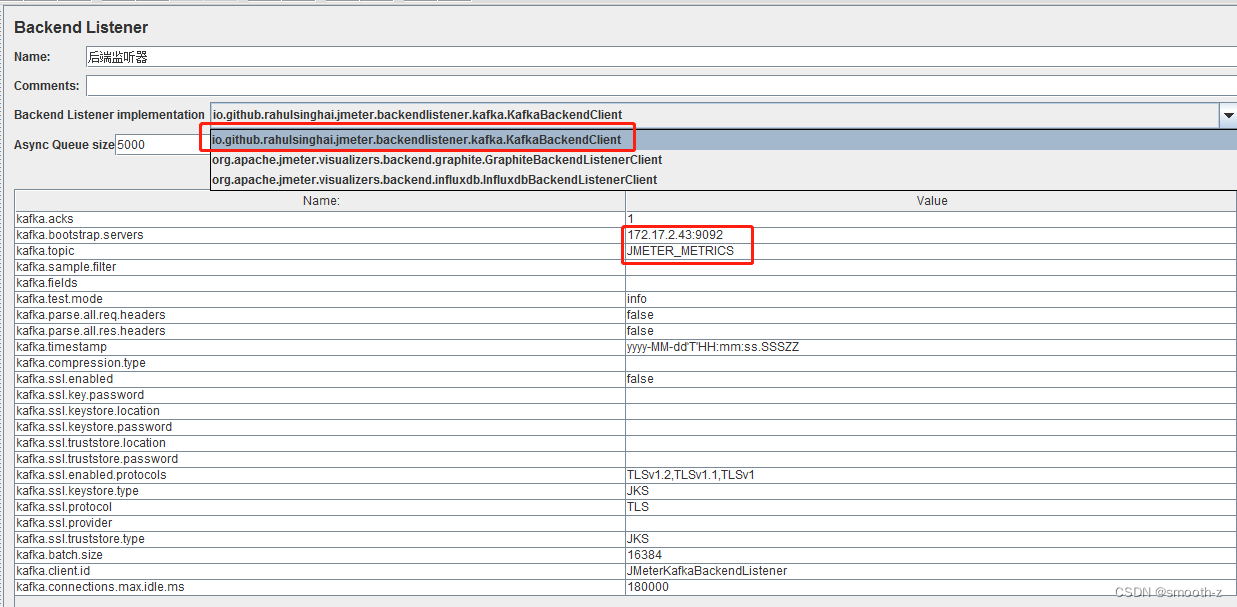
为了快速部署验证环境,我这次用Docker装了Kafka和Zookeeper集群,装了influxdb和Grafana,其中Kafka路径和端口如上图所标示,测试前请确保Kafka服务和端口是连通的。
三、通过后端监听器收集测试结果
我们按上图配置好后端监听器,并执行JMeter测试,然后用Offset Explorer连接kafka可以查看到我们监听器收集到的报告数据:
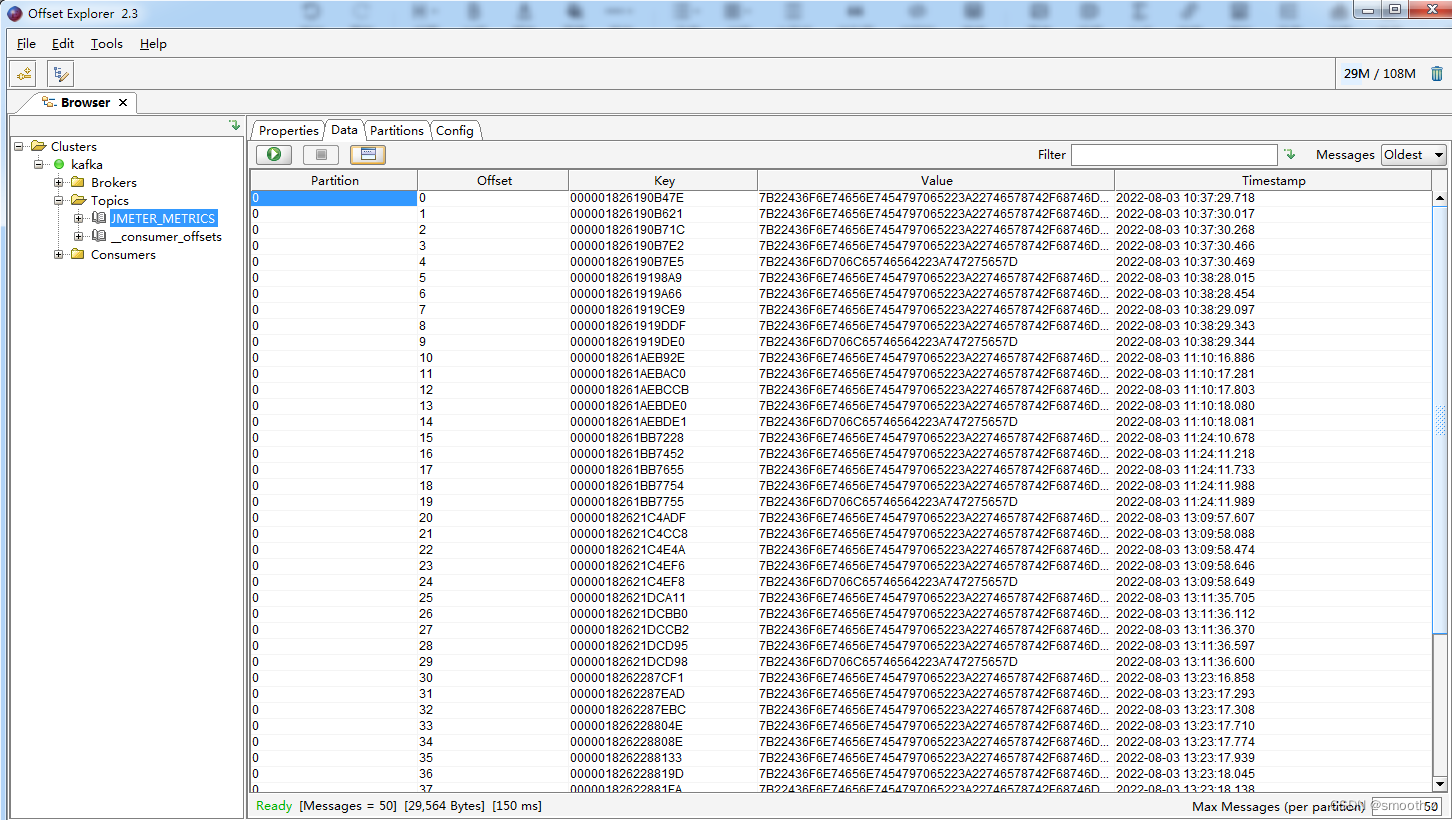
由于存储的是编码后的Key-value格式,我们可以用Telegraf消费消息,往influxdb存储消息,来看收到的是什么消息(当然,你也可以采用别的方式)。
Telegraf的配置如下:
首先配置Output(主要是influxdb的url和database):
###############################################################################
# OUTPUT PLUGINS #
###############################################################################
# Configuration for sending metrics to InfluxDB
[[outputs.influxdb]]
## The full HTTP or UDP URL for your InfluxDB instance.
##
## Multiple URLs can be specified for a single cluster, only ONE of the
## urls will be written to each interval.
# urls = ["unix:///var/run/influxdb.sock"]
# urls = ["udp://127.0.0.1:8089"]
urls = ["http://172.17.2.130:8086"]
## The target database for metrics; will be created as needed.
## For UDP url endpoint database needs to be configured on server side.
database = "kafka"
然后配置Input(为了方便查看只配置kafka,把默认其他的CPU、disk等注释掉,以免干扰):
# # Read metrics from Kafka topic(s)
[[inputs.kafka_consumer]]
# ## kafka servers
brokers = ["172.17.2.43:9092"]
# ## topic(s) to consume
topics = ["JMETER_METRICS"]
# ## Add topic as tag if topic_tag is not empty
topic_tag = "JMETER_METRICS"
# ## the name of the consumer group
consumer_group = "telegraf_metrics_consumers"
# ## Offset (must be either "oldest" or "newest")
offset = "oldest"
# ## Data format to consume.
# ## Each data format has its own unique set of configuration options, read
# ## more about them here:
# ## https://github.com/influxdata/telegraf/blob/master/docs/DATA_FORMATS_INPUT.md
data_format = "value"
data_type = "string"
启动telegraf,看同步数据的日志是否正常:
2022-08-04T00:29:48Z I! Starting Telegraf 1.10.2
2022-08-04T00:29:48Z I! Loaded inputs: kafka_consumer
2022-08-04T00:29:48Z I! Loaded aggregators:
2022-08-04T00:29:48Z I! Loaded processors:
2022-08-04T00:29:48Z I! Loaded outputs: influxdb
2022-08-04T00:29:48Z I! Tags enabled: host=172.17.2.43
2022-08-04T00:29:48Z I! [agent] Config: Interval:10s, Quiet:false, Hostname:"172.17.2.43", Flush Interval:10s
2022-08-04T00:29:48Z I! Started the kafka consumer service, brokers: [172.17.2.43:9092], topics: [JMETER_METRICS]
同步正常,我们就用InfluxDB Studio连接influxdb查看收集到的数据:
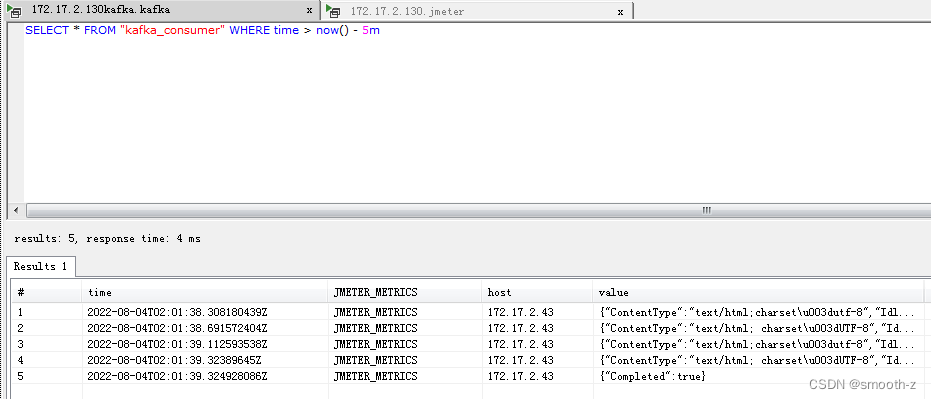
查看value值,可以看到收集到的测试结果内容,value值如下:
{
\"ContentType\":\"text/html; charset\\u003dUTF-8\",
\"IdleTime\":0,
\"ElapsedTime\":\"2022-08-04T00:00:01.000+0800\",
\"ErrorCount\":0,
\"Timestamp\":\"2022-08-04T10:01:22.259+0800\",
\"URL\":\"https://mp.weixin.qq.com/s/dWBD8ZNYnzuao5ca3gMi3Q\",
\"SampleStartTime\":\"2022-08-04T10:01:22.259+0800\",
\"Success\":true,
\"Bytes\":64438,
\"SentBytes\":689,
\"AllThreads\":1,
\"TestElement.name\":\"Thread-11\",
\"DataType\":\"text\",
\"ResponseTime\":396,
\"SampleCount\":1,
\"FailureMessage\":\"\",
\"ConnectTime\":176,
\"ResponseCode\":\"200\",
\"TestStartTime\":1659578481614,
\"AssertionResults\":[
],
\"Latency\":342,
\"InjectorHostname\":\"ZGH-PC\",
\"GrpThreads\":1,
\"SampleEndTime\":\"2022-08-04T10:01:22.655+0800\",
\"BodySize\":61665,
\"ThreadName\":\"threadGroup 1-1\",
\"SampleLabel\":\"chrome-192.168.1.246\"
}
其实我们看kafka监听器的源码/jmeter/backendlistener/model/MetricsRow.java,也能知道收集的测试结果数据格式:
public Map<String, Object> getRowAsMap(BackendListenerContext context, String servicePrefixName)
throws UnknownHostException {
SimpleDateFormat sdf = new SimpleDateFormat(this.kafkaTimestamp);
// add all the default SampleResult parameters
addFilteredMetricToMetricsMap("AllThreads", this.sampleResult.getAllThreads());
addFilteredMetricToMetricsMap("BodySize", this.sampleResult.getBodySizeAsLong());
addFilteredMetricToMetricsMap("Bytes", this.sampleResult.getBytesAsLong());
addFilteredMetricToMetricsMap("SentBytes", this.sampleResult.getSentBytes());
addFilteredMetricToMetricsMap("ConnectTime", this.sampleResult.getConnectTime());
addFilteredMetricToMetricsMap("ContentType", this.sampleResult.getContentType());
addFilteredMetricToMetricsMap("DataType", this.sampleResult.getDataType());
addFilteredMetricToMetricsMap("ErrorCount", this.sampleResult.getErrorCount());
addFilteredMetricToMetricsMap("GrpThreads", this.sampleResult.getGroupThreads());
addFilteredMetricToMetricsMap("IdleTime", this.sampleResult.getIdleTime());
addFilteredMetricToMetricsMap("Latency", this.sampleResult.getLatency());
addFilteredMetricToMetricsMap("ResponseTime", this.sampleResult.getTime());
addFilteredMetricToMetricsMap("SampleCount", this.sampleResult.getSampleCount());
addFilteredMetricToMetricsMap("SampleLabel", this.sampleResult.getSampleLabel());
addFilteredMetricToMetricsMap("ThreadName", this.sampleResult.getThreadName());
addFilteredMetricToMetricsMap("URL", this.sampleResult.getURL());
addFilteredMetricToMetricsMap("ResponseCode", this.sampleResult.getResponseCode());
addFilteredMetricToMetricsMap("TestStartTime", JMeterContextService.getTestStartTime());
addFilteredMetricToMetricsMap(
"SampleStartTime", sdf.format(new Date(this.sampleResult.getStartTime())));
addFilteredMetricToMetricsMap(
"SampleEndTime", sdf.format(new Date(this.sampleResult.getEndTime())));
addFilteredMetricToMetricsMap(
"Timestamp", sdf.format(new Date(this.sampleResult.getTimeStamp())));
addFilteredMetricToMetricsMap("InjectorHostname", InetAddress.getLocalHost().getHostName());
// Add the details according to the mode that is set
switch (this.kafkaTestMode) {
case "debug":
case "error":
addDetails();
break;
case "info":
if (!this.sampleResult.isSuccessful()) {
addDetails();
}
break;
default:
break;
}
addAssertions();
addElapsedTime(sdf);
addCustomFields(context, servicePrefixName);
parseHeadersAsJsonProps(this.allReqHeaders, this.allResHeaders);
return this.metricsMap;
}
大家发现这些内容,只要经过计算就可以生成JMeter测试报告,有线程数,有响应时间,有Sample名称数量和成功标识、Bytes等指标。但是缺少TPS,90%响应时间等指标,这些指标可以参考Influxdb监听器自己进行扩展和重计数。
四、通过Grafana进行结果展示
以上的Key Value格式是不利于在Grafana中展现的,我们可以在Telegraf中改变传输格式为json:
# # Read metrics from Kafka topic(s)
[[inputs.kafka_consumer]]
# ## kafka servers
brokers = ["172.17.2.43:9092"]
# ## topic(s) to consume 可以添加多个测试项目的topic
topics = ["JMETER_METRICS"]
# ## Add topic as tag if topic_tag is not empty
topic_tag = "JMETER_METRICS"
# ## the name of the consumer group
consumer_group = "telegraf_metrics_consumers"
# ## Offset (must be either "oldest" or "newest")
offset = "oldest"
# ## Data format to consume.
# ## Each data format has its own unique set of configuration options, read
# ## more about them here:
# ## https://github.com/influxdata/telegraf/blob/master/docs/DATA_FORMATS_INPUT.md
data_format = "json"
再次测试,这时候发现能够在influxdb中按不同字段显示指标值了:

但是展示的字段不全,到telegraf官网查看配置说明,发现可以添加显示字段:

修改telegraf.conf配置,在data_format配置下添加缺少的字段,同时把SampleLabel添加为tag Key(也可以按需要添加多个):
# ## Data format to consume.
# ## Each data format has its own unique set of configuration options, read
# ## more about them here:
# ## https://github.com/influxdata/telegraf/blob/master/docs/DATA_FORMATS_INPUT.md
data_format = "json"
tag_keys = ["SampleLabel"]
json_string_fields=["Success", "ThreadName", "SampleLabel", "Timestamp", "URL", "FailureMessage", "ResponseCode", "AssertionResults", "InjectorHostname", "SampleStartTime", "SampleEndTime"]
再次测试,查看inluxdb中同步的结果数据,发现能看到更多的字段了:

有了这些字段,我们就可以在grafana中配置展示:
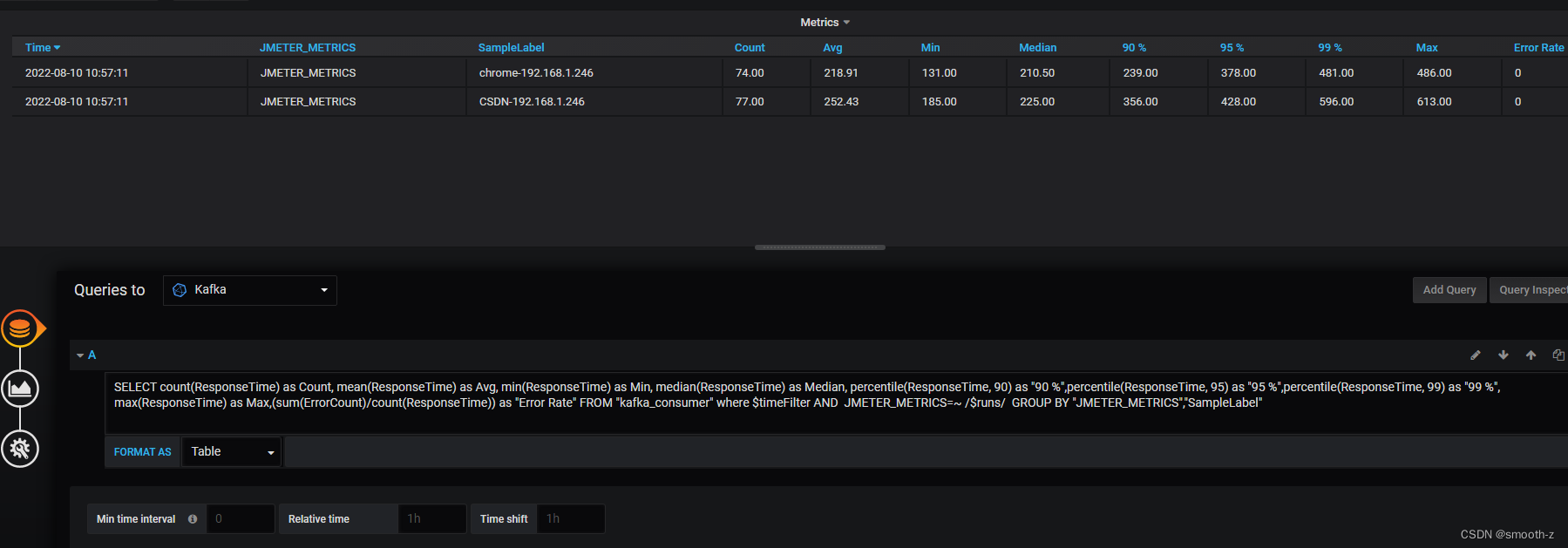
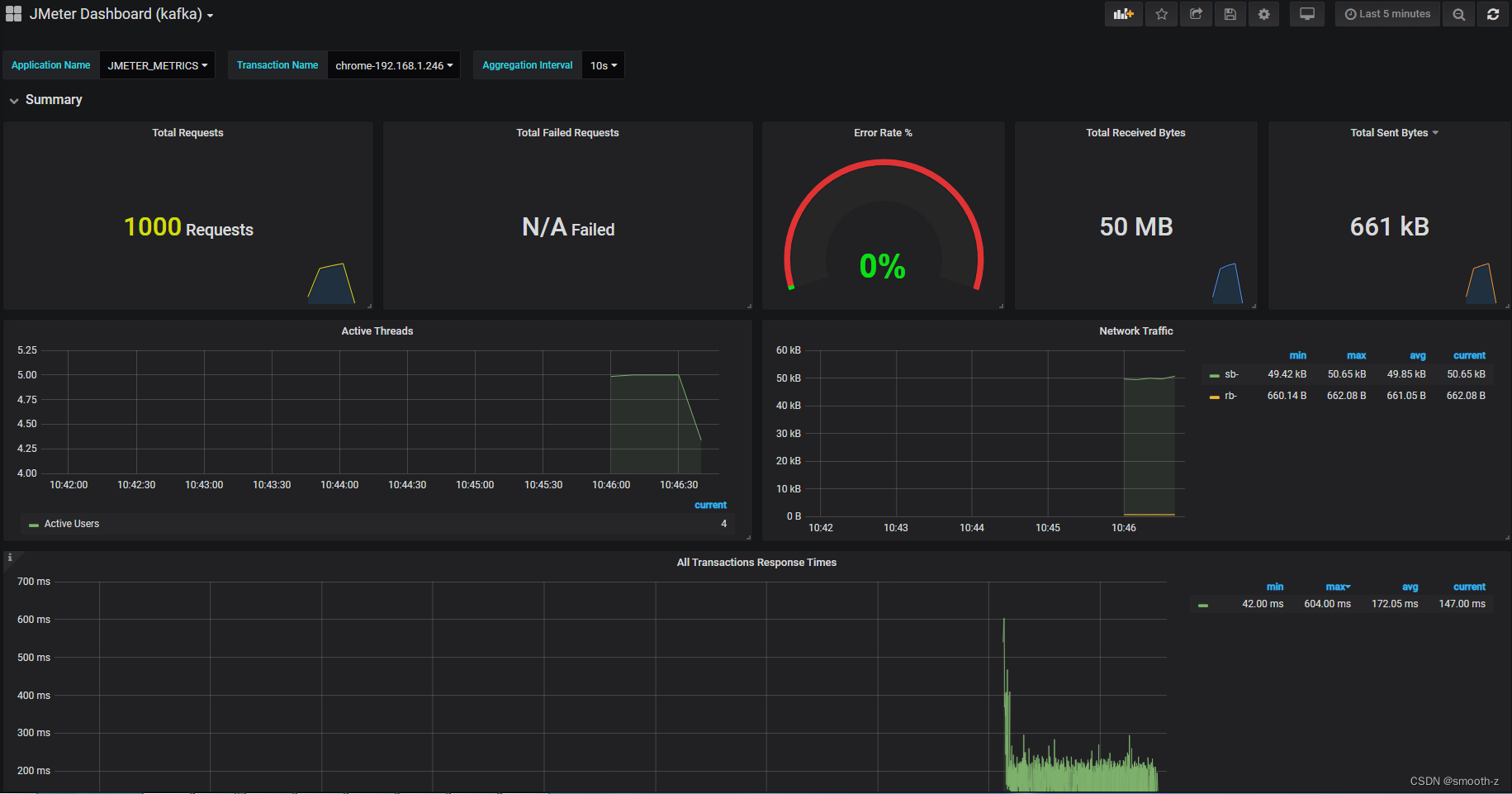
五、Kafka监听器插件扩展开发
通过上面的演示,我们发现不能像influxdb后端监听器那样收集到【点击率hits】等常规的性能指标,那么我们可以参考Influxdb后端监听器的源码对Kafka监听器进行改造,同过由上面提到的监听器原理可以知道,监听器是通过handleSampleResults方法来处理数据并上报至kafka或influxdb,那么我们就从这个函数着手,这个函数所属于KafkaBackendClient.java类文件中:
io.github.rahulsinghai.jmeter.backendlistener.kafka.KafkaBackendClient
我们将handleSampleResults方法修改如下(注释为add的内容):
@Override
public void handleSampleResults(List<SampleResult> results, BackendListenerContext context) {
for (SampleResult sr : results) {
String sampleLabel = sr.getSampleLabel(); // add部分
SamplerMetric samplerMetric = getSamplerMetric(sampleLabel); // add部分
/* jmeter 5.1.1之后版本,SamplerMetric支持addCumulated
Pattern samplersToFilter;
if (samplersToFilter.matcher(sampleLabel).find()) {
samplerMetric.add(sr);
}
samplerMetric = getSamplerMetric("all");
samplerMetric.addCumulated(sr);
*/
samplerMetric.add(sr); // add部分
MetricsRow row =
new MetricsRow(
sr,
context.getParameter(KAFKA_TEST_MODE),
context.getParameter(KAFKA_TIMESTAMP),
this.buildNumber,
context.getBooleanParameter(KAFKA_PARSE_REQ_HEADERS, false),
context.getBooleanParameter(KAFKA_PARSE_RES_HEADERS, false),
fields,
samplerMetric); // add参数samplerMetric
if (validateSample(context, sr)) {
try {
// Prefix to skip from adding service specific parameters to the metrics row
String servicePrefixName = "kafka.";
this.publisher.addToList(new Gson().toJson(row.getRowAsMap(context, servicePrefixName)));
} catch (Exception e) {
logger.error(
"The Kafka Backend Listener was unable to add sampler to the list of samplers to send... More info in JMeter's console.");
e.printStackTrace();
}
}
}
我们在这个方法中增加了SamplerMetric的调用(上面标示的add 部分),关于SamplerMetric类中我们可以看到有我们需要的指标计算,可以get到我们所要的指标,如下:
public int getTotal() {
return successes+failures;
}
public int getSuccesses() {
return successes;
}
public int getFailures() {
return failures;
}
public double getOkMaxTime() {
return okResponsesStats.getMax();
}
public double getOkMinTime() {
return okResponsesStats.getMin();
}
public double getOkMean() {
return okResponsesStats.getMean();
}
public double getOkPercentile(double percentile) {
return okResponsesStats.getPercentile(percentile);
}
public double getKoMaxTime() {
return koResponsesStats.getMax();
}
public double getKoMinTime() {
return koResponsesStats.getMin();
}
public double getKoMean() {
return koResponsesStats.getMean();
}
public double getKoPercentile(double percentile) {
return koResponsesStats.getPercentile(percentile);
}
public double getAllMaxTime() {
return allResponsesStats.getMax();
}
public double getAllMinTime() {
return allResponsesStats.getMin();
}
public double getAllMean() {
return allResponsesStats.getMean();
}
public double getAllPercentile(double percentile) {
return pctResponseStats.getPercentile(percentile);
}
/**
* Returns hits to server
* @return the hits
*/
public int getHits() {
return hits;
}
public Map<ErrorMetric, Integer> getErrors() {
return errors;
}
public long getSentBytes() {
return sentBytes;
}
public long getReceivedBytes() {
return receivedBytes;
}
由于我们在MetricsRow方法调用时加了samplerMetric参数,所以需要改一下MetricsRow类的构造函数(add参数):
public MetricsRow(
SampleResult sr,
String testMode,
String timeStamp,
int buildNumber,
boolean parseReqHeaders,
boolean parseResHeaders,
Set<String> fields,
SamplerMetric samplerMetric) { // add参数 samplerMetric
this.sampleResult = sr;
this.kafkaTestMode = testMode.trim();
this.kafkaTimestamp = timeStamp.trim();
this.ciBuildNumber = buildNumber;
this.metricsMap = new HashMap<>();
this.allReqHeaders = parseReqHeaders;
this.allResHeaders = parseResHeaders;
this.fields = fields;
this.samplerMetric = samplerMetric;
}
然后我们在MetricsRow的getRowAsMap函数中就可以添加SamplerMetric类提供的指标,以下只具例了其中三个指标:
addFilteredMetricToMetricsMap(
"Hits", this.samplerMetric.getHits());
addFilteredMetricToMetricsMap(
"TotalRequest", this.samplerMetric.getTotal());
addFilteredMetricToMetricsMap(
"AllMaxTime", this.samplerMetric.getAllMaxTime());
重新构建 jmeter-backend-listener-kafka 的源代码,生成jar包,替换Jmeter原来的jar包,重新测试,这回我们就可以看到数据库中收集到指标就有Hits了:

这样添加指标的目的就达到了,如果还需要其他指标,也可以基于这个方式继续在MetricsRow中的getRowAsMap函数中添加各类指标,以上过程其实不难理解,只要懂点Java的并在理解了监听器原理后,参照influxdb监听器的源代码我们就轻松完成Kafka监听器的改造,如果对性能指标的计算原理了解的话,还可以扩展个性化的性能指标计算。
当然,我们完全可以不用去改造jmeter-backend-listener-kafka,只要在外部加个处理程序,对收集到的基础sampler指标值进行重计算,就像JMeter的html报告生成那样,通过计算也能得到想要的性能测试报告。另外还可以像Metersphere那样,加个 data-streaming 读取kafka数据,并重计算后发给mysql保存,最后从mysql读取测试结果数据进行报告展现(其中data-streaming对测试结果数据的计算处理应该也是借鉴了JMeter原生代码)
六、有关influxdb2.x应用介绍
由于influxdb已经推出2.x版本,以上都是基于1.x版本,下一篇文章会提到influxdb2监听器的使用《JMeter关于influxDB 2.x 后端监听器使用》,对于Kafka监听器来说,通过telegraf也可以支持influxdb2的数据格式传输,目前telegraf已经支持influxdb2的数据写入:
[[outputs.influxdb_v2]]
urls = ["http://localhost:8086"]
token = "$INFLUX_TOKEN"
organization = "example-org"
bucket = "example-bucket"
参考influxdb的官方文档Manually configure Telegraf for InfluxDB v2.0 | InfluxDB OSS 2.0 Documentation
传给influxdb2的数据在influxdb界面上也可以查询的到:
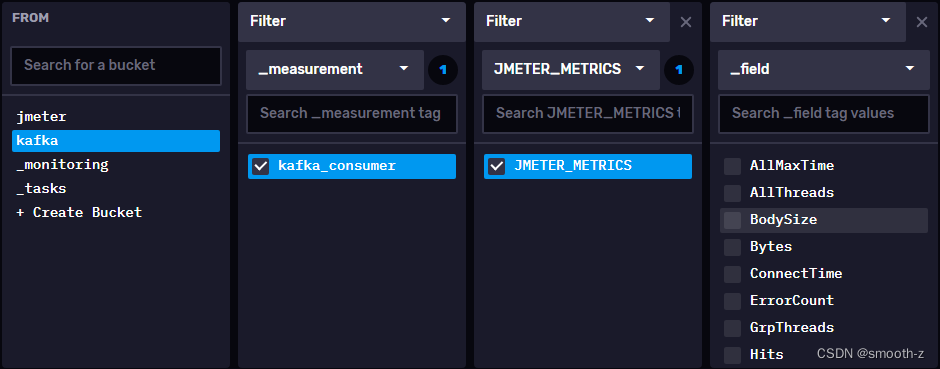
通过InfluxDB 2.x的flux语法可以展示Hits图:
from(bucket: "kafka")
|> range(start: v.timeRangeStart, stop: v.timeRangeStop)
|> filter(fn: (r) => r["_measurement"] == "kafka_consumer")
|> filter(fn: (r) => r["JMETER_METRICS"] == "JMETER_METRICS")
|> filter(fn: (r) => r["_field"] == "Hits")
|> aggregateWindow(every: v.windowPeriod, fn: mean, createEmpty: false)
|> yield(name: "mean")
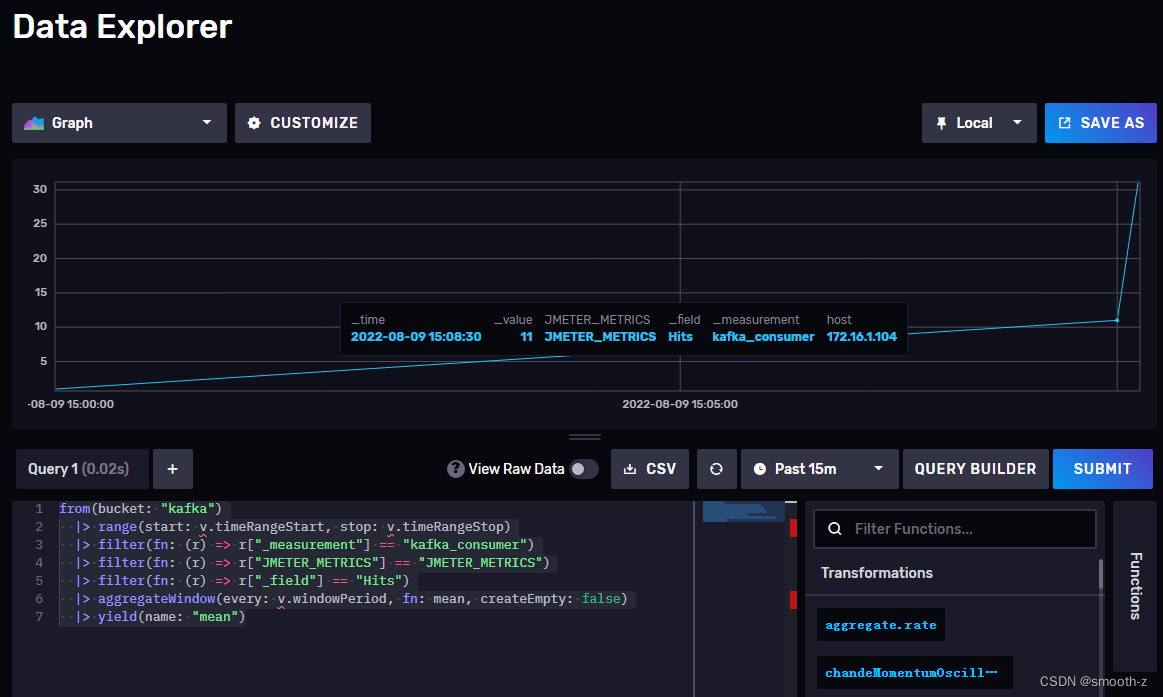 目前主要是Grafana官网上提供Jmeter的influxdb2格式模板比较少,希望以后能多一些,因为基于influxdb2.x的Grafana展示效果会比influxdb1.x要好。
目前主要是Grafana官网上提供Jmeter的influxdb2格式模板比较少,希望以后能多一些,因为基于influxdb2.x的Grafana展示效果会比influxdb1.x要好。
版权归原作者 smooth-z 所有, 如有侵权,请联系我们删除。